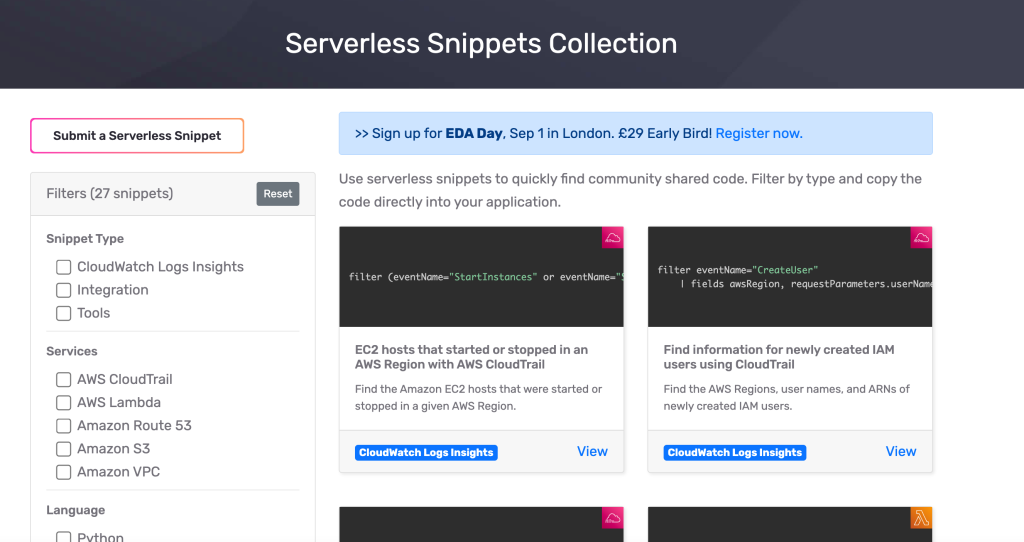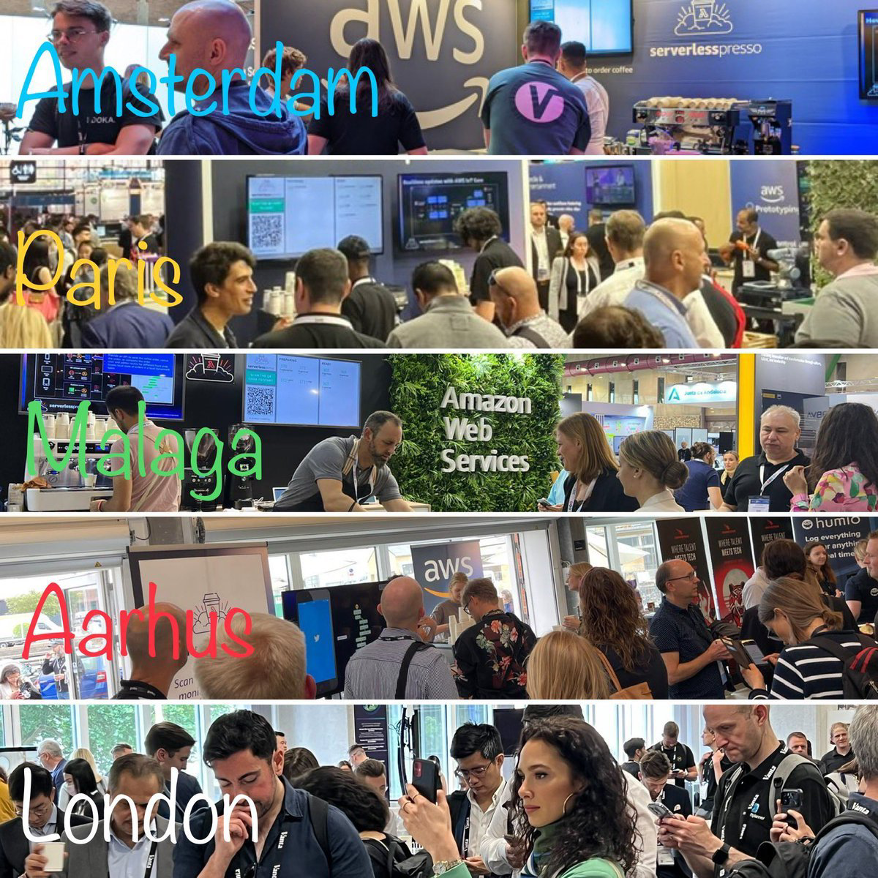Post Syndicated from dboyne original https://aws.amazon.com/blogs/compute/introducing-the-new-aws-serverless-snippets-collection/
Today, the AWS Serverless Developer Advocate team introduces the Serverless Snippets Collection. This is a new page hosted on Serverless Land that makes it easier to discover, copy, and share common code that can help with serverless application development.
Builders are writing serverless applications in many programming languages and spend a growing amount of time finding and reusing code that is trusted and tested.
With many online resources and code located within private repositories, it can be hard to find reusable or up-to-date code snippets that you can copy and paste into your applications or use with your AWS accounts. Code examples can soon become out of date or replaced by new best practices.
The Serverless Snippets Collection is designed to enable reusable, tested, and recommended snippets driven and maintained by the community. Builders can use serverless snippets to find and integrate tools, code examples, and Amazon CloudWatch Logs Insights queries to help with their development workflow.
This blog post explains what serverless snippets are and what challenges they help to solve. It shows how to use the snippets and how builders can contribute to the new collection.
Overview
The new Serverless Snippets Collection helps builders explore and reuse common code snippets to help accelerate application development workflows. Builders can also write their own snippets and contribute them to the site using standard GitHub pull requests.
Serverless snippets are organized into a number of categories, initially supporting Amazon CloudWatch Logs Insights queries, tools, and service integrations.
Code snippets can easily become outdated as new functionality emerges and best practices are discovered. Serverless snippets offer a platform where application developers can collaborate together to keep code examples up to date and relevant, while supporting many programming languages.
Snippets can contain code from any programming language. You can include multiple languages within a single snippet giving you the option to be creative and flexible.
Serverless snippets use tags to simplify discovery. You can use tags to filter by snippet type, programming language, AWS service, or custom tags to find relevant code snippets for your own use cases.
Each snippet type has a custom interface, giving builders a simplified experience and quick deployment methods.
CloudWatch Logs Insights snippets
CloudWatch Logs Insights enables you to search interactively and analyze your log data in CloudWatch Logs. You can use CloudWatch Logs Insights to help you efficiently and effectively search for operational issues, and debug your applications.
Serverless snippets contain a number of CloudWatch Logs Insights queries. These help you analyze your applications faster and include tags such as memory, latency, duration, or errors. You can launch queries directly into your AWS Management Console with one click.
Using CloudWatch Insights snippets
- Select the CloudWatch Logs Insights as the snippet type and choose View on a snippet.

- Select Open in CloudWatch Insights to launch the snippet directly into your AWS account or copy the code and follow the manual instructions on the page to run the query.

Tool snippets
Another snippet type supported are tools. Builders can search for tools by programming language or AWS service. Tool snippets include detailed instructions on how to install the tool and example usage with additional resource links. Tools can also be tagged by programming language allowing you to select the tools for your particular language using the snippet tabs functionality.
To use tools snippets:
- Select Tools as the selected snippet type and View any tool snippet.

- Each snippet may have many steps. Follow the instructions documented in the tool snippet to install and use within your own application.

Integration snippets
Service integrations are part of many applications built on AWS. Serverless snippets include integration type snippets to share integration code between AWS services.
For example, you can add a snippet for Amazon S3 integration with AWS Lambda and also split your snippet into programming languages.
To use integration snippets:
- Select Integration as the selected snippet type and View any tool snippet.

- The integrations snippets give you examples of how you can integrate between AWS services. You can select your desired programming language by selecting the language buttons.

Contributing to the Serverless Snippets Collection
You can write your own snippets and contribute them to the serverless snippets collection, which is stored in the AWS snippets-collection repository. Requests are reviewed for quality and relevancy before publishing.
To submit a snippet:
- Choose Submit a Serverless Snippet.

- Read the Adding new snippet guide and fill out the GitHub issue template.
- Clone the repository. Duplicate and rename the example snippet_model directory (or _snippet-model-multi-files if you want to support multiple files in your snippet)
- Add required information in the README.md file.
- Add the required meta information to `snippet-data.json`
- Add the snippet code to the snippet.txt file.
- Submit a pull request to the repository with the new snippet files.
To write snippets with multiple code blocks or to support different runtimes, read the guide.
Conclusion
When building serverless applications, builders reuse and share code across many applications and organizations. These code snippets can be difficult to find across your own applications and local development environments.
Today, the AWS Serverless Developer Advocate team is adding the Serverless Snippets Collection on Serverless Land to help builders search, discover, and contribute reusable code snippets across the world.
The Serverless Snippet Collection includes tools, integration code examples and CloudWatch Logs Insights queries. The collection supports many types of snippets, examples, and code that can be shared across the community.
Builders can use the custom filter functionality to search for snippets by programming language, AWS service, or custom snippet tags.
All serverless developers are invited to contribute to the collection. You can submit a pull request to the Serverless Snippets Collection GitHub repository, which is reviewed for quality before publishing.
For more information on building serverless applications visit Serverless Land.
















